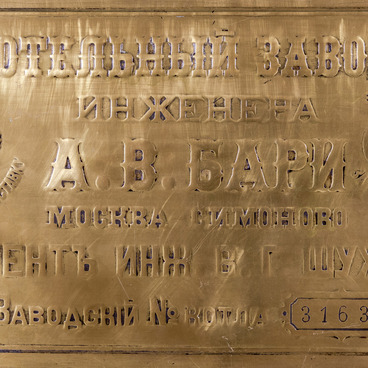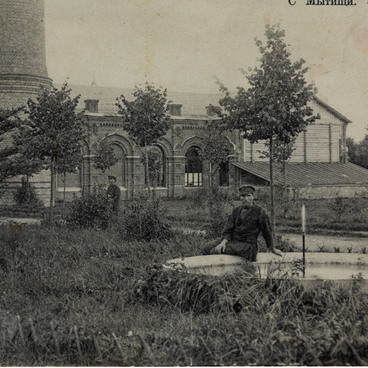After the abolition of serfdom, more new plants and factories appeared in Russia, while the old ones were gradually renovated. As a result of the Reform, the core of the manpower was composed of independent contractors only.
In 1864, the Moscow industrialists named the Chernyshovs built a wool-spinning and cloth-looming factory in place of a small facility near the Pirogovo village. At first, Pelageya Chernyshova shared it with a famous manufacturer Alexei Khludov, but 18 months later she bought out the entire factory for herself. In 1872, the Partnership of Pelageya Chernyshova and Sons was established. By that time, she had become a widow with five sons. A part of the Chernyshov family lived in Moscow where they owned two more factories: a cloth-looming in the Basmannaya area and a silk-spinning in Lefortovo. Three of the Chernyshov brothers lived in their house near the Pirogovo factory.
The facility grew quickly. In 1916, the population of the workers' village reached 4,000, two-thirds of whom were newcomer peasants who hadn’t yet cut all ties with the farming life. A work day was 12 to 14 hours depending on the worker’s qualifications, and monthly salaries varied from 10 to 25 rubles.
In the beginning, the factory produced expensive all-wool fabrics: drape cloth, tricot, thick felt. Gradually they switched to cheaper cotton-based products: fabrics for militia and school uniform, caps. During World War One, the factory received large orders from the military for greatcoat fabric. Almost all operations at the factory were done by hand.
The workers' village appeared right after the factory was established. Several wooden houses were built for the employed laborers. They were accommodated in four main dormitories. Downstairs were rooms for single workers, while families lived on the two upper floors. The factory had its own store that sold products on credit.
In 1880, they opened a hospital with seven beds. In 1892, the factory built a school for 30 students where all disciplines were taught by the office clerk Zubarev. In 1893, they opened a parochial school with 3 classes of 60 students, with the teacher named Sveshnikov and the priest Golubev. In 1898, the factory launched a Temperance Society, and 260 joined it. The Society was stationed in a two-story stone building with a library, a tea room, and a hall with a stage. The library was managed by a big book lover Pyotr Knyazev. The Society organised a drama club where they performed plays by Alexander Ostrovsky and Anton Chekhov.
In late 1917, the factory was nationalized.
In 1864, the Moscow industrialists named the Chernyshovs built a wool-spinning and cloth-looming factory in place of a small facility near the Pirogovo village. At first, Pelageya Chernyshova shared it with a famous manufacturer Alexei Khludov, but 18 months later she bought out the entire factory for herself. In 1872, the Partnership of Pelageya Chernyshova and Sons was established. By that time, she had become a widow with five sons. A part of the Chernyshov family lived in Moscow where they owned two more factories: a cloth-looming in the Basmannaya area and a silk-spinning in Lefortovo. Three of the Chernyshov brothers lived in their house near the Pirogovo factory.
The facility grew quickly. In 1916, the population of the workers' village reached 4,000, two-thirds of whom were newcomer peasants who hadn’t yet cut all ties with the farming life. A work day was 12 to 14 hours depending on the worker’s qualifications, and monthly salaries varied from 10 to 25 rubles.
In the beginning, the factory produced expensive all-wool fabrics: drape cloth, tricot, thick felt. Gradually they switched to cheaper cotton-based products: fabrics for militia and school uniform, caps. During World War One, the factory received large orders from the military for greatcoat fabric. Almost all operations at the factory were done by hand.
The workers' village appeared right after the factory was established. Several wooden houses were built for the employed laborers. They were accommodated in four main dormitories. Downstairs were rooms for single workers, while families lived on the two upper floors. The factory had its own store that sold products on credit.
In 1880, they opened a hospital with seven beds. In 1892, the factory built a school for 30 students where all disciplines were taught by the office clerk Zubarev. In 1893, they opened a parochial school with 3 classes of 60 students, with the teacher named Sveshnikov and the priest Golubev. In 1898, the factory launched a Temperance Society, and 260 joined it. The Society was stationed in a two-story stone building with a library, a tea room, and a hall with a stage. The library was managed by a big book lover Pyotr Knyazev. The Society organised a drama club where they performed plays by Alexander Ostrovsky and Anton Chekhov.
In late 1917, the factory was nationalized.



